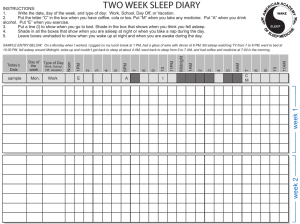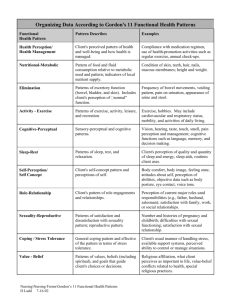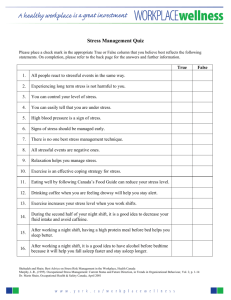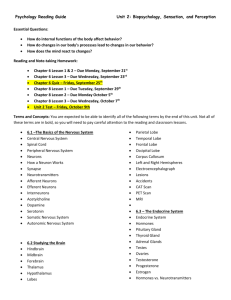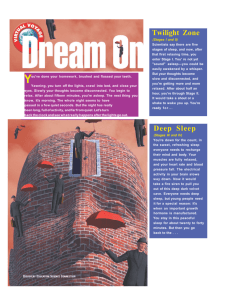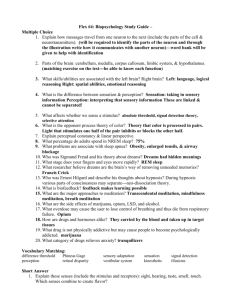PSYCHOLOGY UNIT 2 EXAM: Part 1 Multiple Choice: Choose the
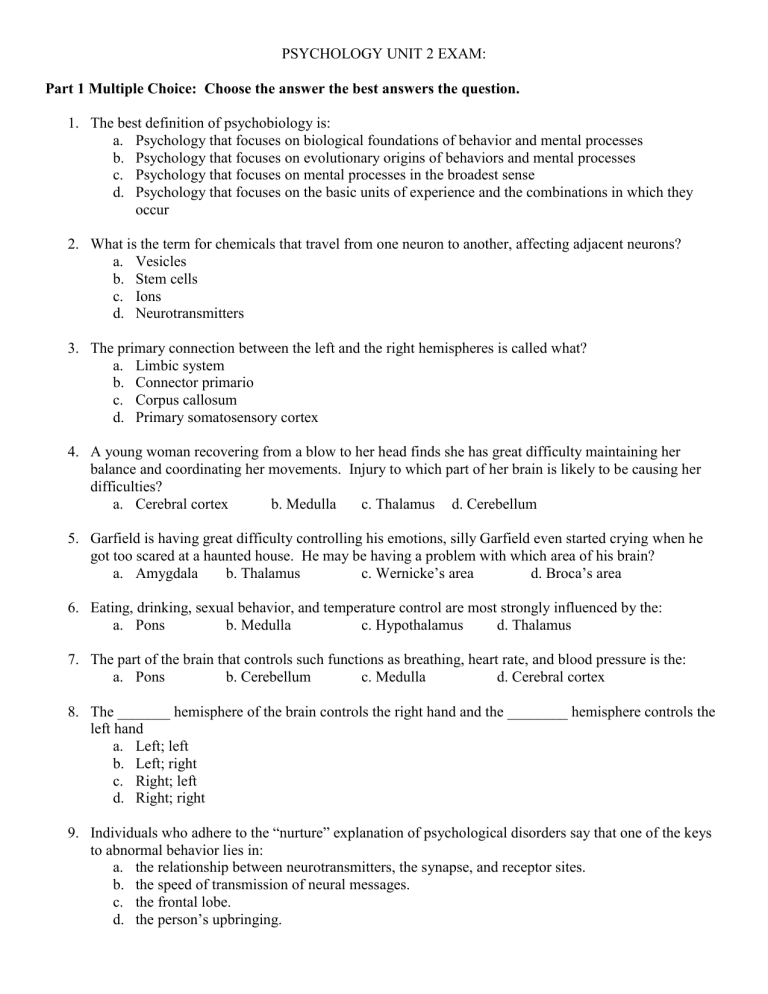
PSYCHOLOGY UNIT 2 EXAM:
Part 1 Multiple Choice: Choose the answer the best answers the question.
1.
The best definition of psychobiology is: a.
Psychology that focuses on biological foundations of behavior and mental processes b.
Psychology that focuses on evolutionary origins of behaviors and mental processes c.
Psychology that focuses on mental processes in the broadest sense d.
Psychology that focuses on the basic units of experience and the combinations in which they occur
2.
What is the term for chemicals that travel from one neuron to another, affecting adjacent neurons? a.
Vesicles b.
Stem cells c.
Ions d.
Neurotransmitters
3.
The primary connection between the left and the right hemispheres is called what? a.
Limbic system b.
Connector primario c.
Corpus callosum d.
Primary somatosensory cortex
4.
A young woman recovering from a blow to her head finds she has great difficulty maintaining her balance and coordinating her movements. Injury to which part of her brain is likely to be causing her difficulties? a.
Cerebral cortex b. Medulla c. Thalamus d. Cerebellum
5.
Garfield is having great difficulty controlling his emotions, silly Garfield even started crying when he got too scared at a haunted house. He may be having a problem with which area of his brain? a.
Amygdala b. Thalamus c. Wernicke’s area
d. Broca’s area
6.
Eating, drinking, sexual behavior, and temperature control are most strongly influenced by the: a.
Pons b. Medulla c. Hypothalamus d. Thalamus
7.
The part of the brain that controls such functions as breathing, heart rate, and blood pressure is the: a.
Pons b. Cerebellum c. Medulla d. Cerebral cortex
8.
The _______ hemisphere of the brain controls the right hand and the ________ hemisphere controls the left hand a.
Left; left b.
Left; right c.
Right; left d.
Right; right
9.
Individuals who adhere to the “nurture” explanation of psychological disorders say that one of the keys to abnormal behavior lies in: a.
the relationship between neurotransmitters, the synapse, and receptor sites. b.
the speed of transmission of neural messages. c.
the frontal lobe. d.
the person’s upbringing.
10.
Bill was researching whether or not aggression was a genetic trait. He decided to use mice for his study; he bred closely related mice and recorded the characteristics of their offspring. Bill has used a a.
Family study b.
Strain study c.
Selective study d.
Inbreeding study
11.
The MAIN reason psychologists use animals over humans to study behavioral genetics is because: a.
It would not be ethical to perform many of the experiments on humans b.
It would be a lot more expensive to perform many of the experiments on humans c.
The results would be less accurate if the experiments used humans d.
Cause’ their lazy
12.
Stacey has a genetic disposition for obesity which is her ____________; however, Stacy makes a conscious effort to eat healthy and exercise 2-3 times a week, her average weight and healthy BMI is her
____________________: a.
Amydala, hypothalamus b.
Right hemisphere, left hemisphere c.
Phenotype, genotype d.
Genotype, phenotype
13.
How many hours of sleep do adolescents need?: a.
8 b.
8.25 c.
9 d.
9.25
14.
Sensation is: a.
The organization of stimuli to create meaningful patterns b.
The basic experience of stimulating the body’s senses c.
The result of activity in the efferent nervous system d.
The presence of sensory cell activity in the absence of external stimulation
15.
Psychologists mainly focus on _______________ because it is the primary way we experience our world. a.
Vision b. Speech c. Taste
16.
Receptor cells in the retina responsible for color vision are: a.
Rods b. Bipolar cells c. Ganglion cells d. Touch d. Cones
17.
The following is a chemical sense: a.
Vision b.
Hearing c.
Kinesthetic d.
None of the above
18.
Some animals “see” more with their ears than with their eyes by making high-pitched chirps so they bounce off nearby objects, this in an example of: a.
Pheromones b.
Kinesthetic c.
Echolocation d.
Ear perception
19.
When you see Ms. Duco walking from a distance in the hallway although she may look 3 feet tall you know she is not, you are confident she remained the same height although perceived otherwise. This is known as: a.
Linear disposition b.
Perceptual Constancy c.
Relative height d.
Motion Parallax
20.
A psychologist who asked you to make a series of judgments to determine whether or not a light was present in an unlighted room would be trying to assess your _____________________________ for perceiving light. a.
Psychometric function c. Response bias b. Absolute threshold d. Just noticeable difference (jnd)
21.
The fact that 50% of the time we can taste a difference in taste when .009 ounces of hot sauce is added to mac and cheese demonstrates what? a.
Absolute threshold b.
Difference threshold c.
Adaptation d.
Sensation
22.
Adaptation is the process in which: a.
Visual acuity improves as one centers an object’s light on the fovea. b.
Receptor sensitivity changes as a result of continued exposure to a stimulus. c.
Receptor cells become linked with one another. d.
Nonspectral colors can be seen.
23.
_____________________ is the mental process of sorting, identifying, and arranging the raw data of experience into meaningful patterns. a.
Sensation b. Consciousness c. Perception d. Abstraction
24.
This perception of movement is what we commonly experience when looking out the window, objects further away appear to be moving more slowly than objects closer to you a.
Autokinetic illusion b. Induced movement c. Motion parallax d. Stroboscopic motion
25.
A technique by which messages can supposedly be sent to consumers, prompting them to buy a product without them ever being aware of receiving such messages is: a.
Subliminal perception b. Selective perception d. Cognitive restructuring c. Inductive perception
26.
When people are focusing on counting the number of passes a basketball team makes they will not notice a moon walking bear walk across the screen. This is best described by a.
Change blindness b.
Stupidity c.
Forced focus d.
Inattentional blindness
27.
Before the first day of class Mr. Salisbury had a dream that he came into his classroom for block 1 and no students showed up. The literal content of his dream, an empty classroom, is considered the
__________________ content while the hidden meaning of his dream, that he is nervous he forgot to do something before school started, is considered the __________ content a.
Manifest, latent b.
Latent, manifest c.
Factual, Freudian d.
Subliminal, absolute
Part 2 True and False: Fill in A for true; B for false.
28.
Neurons communicate messages with the use of neurotransmitters.
29.
If someone has their corpus callosum severed they will not be able to live a normal life (as in hold a job, attend school, etc.)
30.
Genotype and Phenotype always match up
31.
Weber’s law states that different threshold is a constant fraction of the original stimulus
32.
We day dream less than 1/3 of the day
33.
Research shows that outside of the laboratory subliminal messages are not effective in changing behavior.
34.
Pheromones are not effective in influencing human behavior
35.
Emotional factors do not influence perception
36.
Hypnosis works best on people who do not have rich fantasy lives, they do not easily get lost in a book or movie.
Part 3 Matching: Match each neurotransmitter with the corresponding functions. Mark the correct letter on your scantron.
A.
Acetylcholine B. Dopamine C. Serotonin D. Norepinephrine E. Endorphins
37. Involved in the regulation of sleep, dreaming, mood, eating, pain, and aggressive behavior.
38. Affects arousal, wakefulness, learning, memory, and mood.
39. Involved in arousal, attention, memory, motivation, and movement.
40. Involved voluntary movement, learning, memory, and emotions.
41. Involved in the inhibition of pain and ‘runner’s high’
Part 4 Matching: Match the number with the corresponding part of the neuron. Mark the correct letter on your scantron.
A.
AXON B. TERMINAL BUTTON C. MYELIN SHEATH
D. DENDRITE E. NUCLEUS
42
43
44
45
46
Part 5 Matching: Match each number with the corresponding brain part. Mark the correct letter on your scantron.
A.
OCCIPITAL LOBE
D.
FRONTAL LOBE
B. CEREBELLUM C. TEMPORAL LOBE
E. PARIETAL LOBE
47
51
48
49
50
Part 6 Matching: For each patient diagnose the described sleeping disorder. Mark the correct letter on your scantron.
A.
REM Motor Behavior Disorder B. Obstructive Sleep Apnea C. Narcolepsy D. Insomnia
52. Megan
The patient is the CEO of a large corporation in her late 40’s. She reports that he suffers from excessive fatigue and sleepiness during the day. She often has difficulty concentrating and performing her routine tasks. Her husband has never witnessed her doing any unusual activity at night, except some occasional snoring when she has a cold. A physical exam reveals no significant problems; however, after questioning the patient she reveals that she drinks several cups of coffee and diet sodas to stay away during the day. She also has an alcoholic beverage or two to help her sleep. She reports falling asleep okay, but cannot stay asleep for very long and wakes up numerous times and cannot fall back asleep.
53. Nichole
This patient is a female in her early 30’s. She indicates that she has no sleep problems of which she is aware, although she did sleepwalk as a child but not beyond age 10. She falls asleep readily, does not believe she snores, and generally awakens feeling refreshed. She has no bed partner to provide confirmation of sleep behaviors. She seeks help because of two recent incidents. In the first, she awoke at 3:30 a.m. to find herself on the roof of her house, apparently having climbed a ladder to get there. She stated that during the day she had been concerned about a tree branch that was rubbing on her roof but had forgotten about it that night. When she awoke on the roof, she thought that she had just dreamed about climbing a ladder and inspecting the tree branch. The second incident occurred five weeks later. The patient reported having a good day and falling asleep readily. She awoke at 4:00 a.m. sitting under a favorite tree in a nearby park drinking a glass of wine.
Upon awakening in the park, she thought she had been dreaming about being on a picnic with her boyfriend.
54. Barbara
The patient is a female in her mid-20s. She reports difficulty staying awake while away at college. In fact, while in high school, her teachers complained of her falling asleep during class. Her mother has had this problem, although she never sought help from a specialist. The patient feels excessively sleepy during the day.
She sometimes cannot tell if she is dreaming or hallucinating. When she wakes up in the morning she feels glued to her bed as if she cannot move. Finally she mentions that she feels weak when she laughs or is being tickled.
55. Phillip
The patient is a male in his early 30’s. His wife has made him seek help, although he doesn’t see the need. He reports that he has no trouble falling asleep; however, he has multiple awakenings during the night and does not know why. He awakes feeling unrefreshed. He experiences excessive daytime sleepiness. A physical exam is performed. This patient is 6 ft. tall and weighs 255 pounds. His neck measures 21 inches. Two years ago he weighed 200 lbs. The patient indicates that he does snore and that he awakes with his mouth feeling dry. An interview with the patient’s wife reveals that the patient will stop breathing for up to 30 seconds. This is followed by a loud snort.
Part 7: Short answer
1.
Describe the process of a neuron sending a message; include each step of this process. In your answer include the function of each part of the neuron. Use the following terms in your answer:
Axon, terminal buttons, myelin sheath, dendrites, neurotransmitters
2.
Describe a ‘split-brain’ patient, include the brain part that is involved, the functions of the left and right side of the brain, and the consequences of a ‘split-brain’:
3.
Describe the stages of sleep, including what happens in each stage: In your answer include the following terms describing each: melatonin, stage 1, stage 2, stage 3, stage 4, paradoxical sleep, REM, brain waves:
Part 8 Extra Credit: The following questions are extra credit, be as detailed as possible each question is all or nothing.
1.
From the video, what is the mnemonic device used to remember the brain part of the 'hypothalamus’, include the brain function in your answer:
2.
What about our circadian rhythm (biological clock) indicates that out body is meant to take a nap in the middle of the day?
3.
Indicate when day dreaming is negative (2 answers should be included):
4.
Define posthypnotic suggestion:
5.
Describe mirror neurons:
